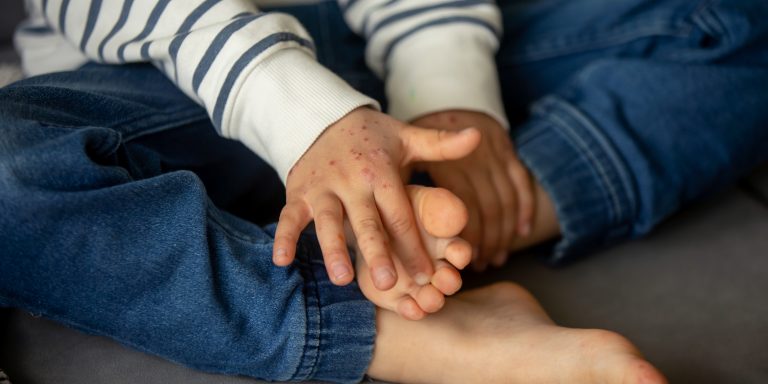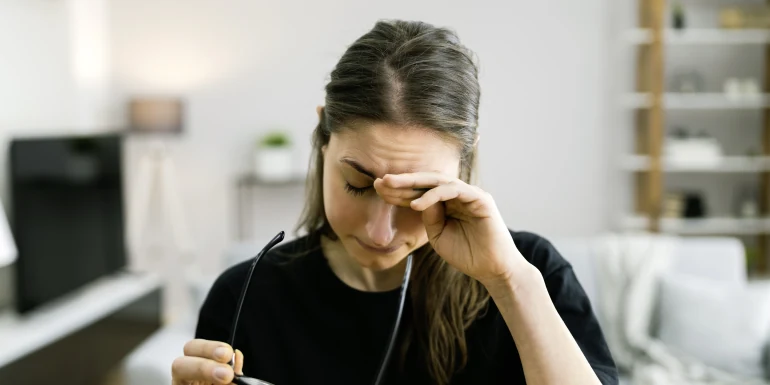
Hand, foot and mouth disease: what can you do about it?
What symptoms may occur with hand, foot and mouth disease and how long does hand, foot and mouth last? And how contagious is hand, foot and mouth for adults? Find out the key facts about the disease and what you can do about it.
What type of disease is hand, foot and mouth?
Hand, foot and mouth disease is a very contagious, but normally harmless, viral infection. It generally affects children under ten, but teenagers and adults can also catch it and become ill from it. The disease is caused by enteroviruses, in particular the coxsackie A virus. Hand, foot and mouth disease can occur at any time of year. However, it is especially common in late summer and autumn.
Hand, foot and mouth is mainly spread via droplets or by direct contact. This can occur for example through coughing, sneezing or direct contact with secretions from blisters. The incubation period – the time from infection to the first symptoms – is generally between three and ten days.
What symptoms occur if you get hand, foot and mouth disease?
Hand, foot and mouth goes through various stages, presenting different symptoms. But over 80 percent of sufferers have no symptoms at all.
- Initial stage: a high temperature, lack of appetite and generally feeling weak are often signs that you are getting the illness. A sore throat is also common, so you initially think you have a common cold. You can also have conjunctivitis.
- After a few days: a rash appears on your skin. With hand, foot and mouth, the rash first appears on your face, around your mouth, before spreading to your hands and feet. The palms of your hands and the soles of your feet are usually affected. Blisters and superficial ulcers can also occur, especially on gums and the inside of your cheeks.
- Later symptoms: hand, foot and mouth also affects fingernails and toenails in rare cases, and the nails can fall off after four to eight weeks. But this is no reason to worry: nails that fall off due to hand, foot and mouth grow back quickly.
Important: in very rare cases, adults as well as children can develop a severe form of hand, foot and mouth disease. For example, it can be triggered by viral strains that are more common in epidemics in the Western Pacific region and Asia. This can lead to dangerous inflammation of the brain or the cerebral membrane.
Medical advice is essential for babies experiencing serious feeding problems, and anyone suffering from vomiting, headaches, cramps, signs of paralysis or disorientation.
Hand, foot and mouth in children and babies
Hand, foot and mouth disease in babies and children usually displays the same symptoms as hand, foot and mouth in adults. Babies can also get a rash in the nappy area, though.
Your child can get hand, foot and mouth several times. Even though the child is protected against the relevant pathogen after contracting the disease the first time, a new infection with a different pathogen, virus strain or sub-variant cannot be ruled out.
Both hand, foot and mouth and chickenpox are childhood illnesses that involve a rash. But there are nevertheless differences between chickenpox and hand, foot and mouth : With chickenpox, the entire body is mostly affected, but, unlike with hand, foot and mouth disease, so is the scalp . The two diseases are also caused by different viruses: hand, foot and mouth is caused by enteroviruses, while chickenpox is triggered by the varicella zoster virus.
Hand, foot and mouth disease during pregnancy
Getting hand, foot and mouth during pregnancy doesn’t usually mean the risk of complications is higher. The symptoms and stages of the disease in pregnant women resemble those for hand, foot and mouth disease in other adults. But it is possible for the infection to be passed on to your baby during birth, so you must talk to your doctor if you think you may have hand, foot and mouth while you are pregnant.
How contagious is hand, foot and mouth for adults and children?
Although hand, foot and mouth disease mostly affects children, adults can also catch it. The risk of infection is greatest in the first week of hand, foot and mouth. It is not possible to say precisely how long you will remain infectious. This is because the viruses can still be excreted through your stool after several weeks. It is important to know that hand, foot and mouth disease is often asymptomatic in both children and adults. This means that it can spread quickly without being detected.
People with hand, foot and mouth disease can still go to work and are not officially banned from attending nursery or school. Nobody has to report that they have the illness in Switzerland. Before going back, though, children must no longer have a high temperature, be in good general health and able to drink normally again.
Hand, foot and mouth disease: how can I prevent it?
There is currently no approved vaccination in Switzerland against hand, foot and mouth, so it’s important to avoid getting the disease. You must therefore wash your hands regularly with soap, especially after going to the toilet and before preparing food.
If a member of the family has hand, foot and mouth disease, extra caution is required. Contaminated objects like toys, cutlery or towels need to be cleaned regularly. Avoid close physical contact with the infected person, especially where they have skin blisters.
How is hand, foot and mouth disease diagnosed?
Hand, foot and mouth disease is diagnosed by looking at the patient’s medical history and performing a physical examination. This means that the doctor asks about the symptoms and how the disease has developed. The doctor then examines the skin and mouth for any rashes or blisters. This examination is generally enough to diagnose hand, foot and mouth disease.
If the symptoms are severe or unclear, the doctor may need to use other methods to make a diagnosis.
Hand, foot and mouth disease: how can I speed up the recovery process?
There is no medication that directly targets the virus behind hand, foot and mouth disease. This is why treatment for the disease involves alleviating the symptoms. Your doctor can prescribe medication that relieves pain or lowers your temperature. However, if you don’t have a high temperature with your hand, foot and mouth disease, you don’t need this medication.
If you have a painful rash, treat it by applying a zinc-based preparation from the pharmacy. Ensure you apply this in a hygienic manner, for example with cotton buds. Special pain-relieving gels or mouthwashes can help in your mouth.
Tips on diet
- Drink plenty – but don’t drink fruit juices or fruit teas, as these can cause a burning sensation.
- Acidic, salty and spicy foods will also be painful at this stage.
- Eating cool or lukewarm foods such as yoghurt, chilled soup or purees will relieve pain, including pain when swallowing.
- An ice lolly will cool and lubricate the mucous membrane in the mouth.
For most people, hand, foot and mouth disease is harmless and gets better on its own after a week. However, babies and anyone with additional symptoms or in severe discomfort should be examined by a doctor.

Sabrina Stollberg is a specialist in general surgery recognised by the Swiss Medical Association (FMH) and a research associate in Helsana’s Public Health Sciences team. She provided the editorial team with advice and input for this article.


Newsletter
Find out more about current health issues every month and get all the information you need about our attractive offers from all Helsana Group companies * delivered by e-mail to read whenever it suits you. Our newsletter is free of charge and you can sign up here:
We did not receive your information. Please try again later.
* The Helsana Group comprises Helsana Insurance Company Ltd, Helsana Supplementary Insurances Ltd and Helsana Accidents Ltd.